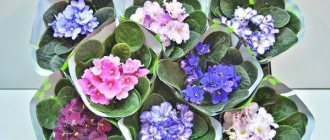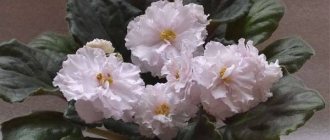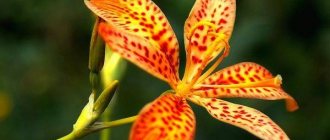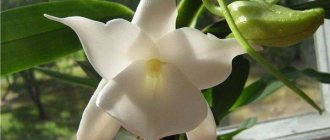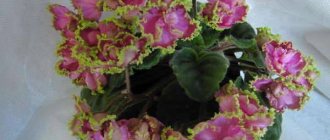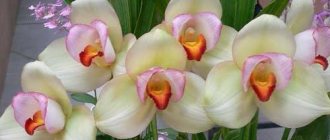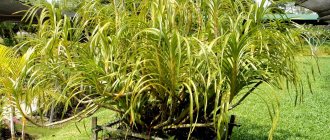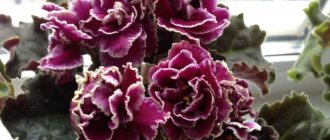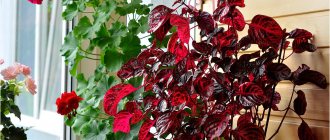Among the many species of orchids, phalaenopsis rightfully occupies a leading place in popularity among lovers of home floriculture.
This tropical, exotic flower, thanks to the achievements of breeders, is not so demanding on conditions and is unpretentious in care. But, without familiarizing themselves with the varietal characteristics and characteristics of growing each species or hybrid, some amateur gardeners experience difficulties growing this miracle plant at home.
Therefore, next we will talk about the varieties of orchids: Deborah, Hummingbird, Catalina, Concord.
Debora, Elegant Debora
Deborah.
Distinctive features
Botanical name: Phalaenopsis Debora (generic).
The roots are fleshy, 3 to 7 mm in diameter, green in color, covered with a layer of velamen, freely branching.
The leaves are oval, with a blunt tip, asymmetrical. The texture of the leaf plate is smooth, leathery. Before flowering, from 6 to 8 leaves are formed, measuring from 19 to 25 cm, with a width of about 7 cm and a thickness of a mature leaf of about 1.5 cm. The color of the leaves is green on the inside and outside.
On average, it produces 2-3 peduncles up to 65 cm in the adult state of the plant . Regular, average height – 55 cm.
The flowers have a typical shape for phalaenopsis - 3 petals and 3 sepals, which are trite. The petals are more pronounced than the sepals. The diameter of the flower in a well-developed plant is approximately 7-8 cm.
The lip is 3-lobed with 2 prominent calluses at the central node of the lateral lobes and at the base of the medial region. The lateral petals of the lip fold upward around the column; the middle extends forward and ends in two thread-like appendages at the apex.
Interesting! A distinctive feature of “Deborah” is her attitude towards black orchids. Although the issue is controversial, since the dark red color depends on the growing conditions and care.
History of the creation of the hybrid
For a large number of hybrids, determining the parental pair is almost impossible. One can only guess what varieties or species were involved in the creation. The Deborah orchid has much in common with the Goodhope variety . The difference is in the size of the flower and the slight predominance of red color.
According to some sources, the closest ancestors were " Doritaenopsis Ching Hua Spring " and " Doritaenopsis Sogo ". Regarding new hybrid forms, it can be assumed that the breeding of the hybrid occurred quite recently, more precisely at the beginning of the 21st century.
Doritaenopsis Ching Hua Spring is one of Deborah's possible parents.
In some Internet sources, “Debora” is called “Red Pioneer”. But there is no exact proof, and according to some descriptions, these are two different hybrids, although they are similar in color.
Common colors
Primary colors are red and violet , with a predominance of red. The edges of the petals have a white edge.
The color of the lip is quite difficult to describe - the base is yellow, ending in white. There is a purple line and some spots along the top edge. Edges with red or purple spots. The dominant color in the center is yellow. In addition, there is a varied combination of the same colors and shades on the lip blades.
Features, duration of flowering and dormant period at home
The inflorescence is vertical, slightly raised, with bilateral symmetrical flowers. The opening of flowers occurs sequentially, starting from the lowest.
Flowering duration occurs from 6 to 8 weeks. With proper care and adequate conditions, an adult plant blooms 2 times a year.
Since the opening of the inflorescences is sequential, the flowering period is quite long. And if there are 3-4 flower stalks, it can continue throughout the year.
Important! Phalaenopsis does not have a specific dormant period. Typically, this period begins immediately after flowering and ends after the plant has gained enough strength and energy for full development.
GENERAL INFORMATION:
Wilsonara Kolibri is a hybrid whose parents are Odontoglossum pescatorei and Wilsonara Intermezzo. Most often, this hybrid goes on sale under the name Cambria.
TEMPERATURE:
This hybrid belongs to a moderate temperature regime, and throughout the year the plants are recommended to be kept under the following conditions:
Day:
18-24 °C (not higher than + 28 °C);
Night:
15-18 °C.
To successfully grow Wilsonara Kolibri at home, it is necessary that the night temperature is always 4 °C lower than the day temperature. For example, if during the day + 22 °C, then at night no more than + 18 °C.
AIR HUMIDITY:
Wilsonara Kolibri is not demanding of extremely high air humidity, and its level can vary from 50 to 70%. Too dry air negatively affects the development of the plant: its growth is slowed down, the tips of the leaves begin to dry out, and new shoots grow crushed like an accordion. To increase air humidity, you can use a humidifier, saucers of water, or wet expanded clay. To do this, take a large tray, inside which expanded clay is poured, a lattice is placed on top to prevent waterlogging of the roots, and pots with orchids are placed. When caring for this type of orchid, the following rule applies: “The higher the thermometer rises, the higher the air humidity should be, and the higher the air humidity, the more often and longer it is necessary to ventilate the room where the orchids are kept, otherwise there is a high probability of rotting and the appearance of leaves of various types of fungal diseases (more details...).”
SUBSTRATE:
This hybrid is grown mainly only in pots. The best substrate is a mixture of coniferous tree bark (Italian pinia pine) with peat and a small proportion of sphagnum moss (10-15%).
TRANSFER:
Frequent replantings are not required for this hybrid, so it is advisable to replant Wilsonara Kolibri only in cases where the substrate is highly salinized, its pH is critically high, or when the plant has grown very much and the old pot becomes too small for it. The best time for replanting is considered to be the period when the new shoots reach a size of 5 cm and begin to grow their own roots (more about replanting...).
LIGHT:
This hybrid loves bright sun without access to direct sunlight, so during the hot midday sun on south-facing windows and the hot evening sun on western windows, the orchid must be placed behind a curtain (for example, on a table near the window) or in the shade of other plants.
WATERING:
Watering this hybrid directly depends on the temperature; the higher it is, the more often and more abundantly it needs to be watered. When watering, excess water should flow freely from the pot, since stagnation of water both inside the pot and in its tray can very quickly lead to rotting of the roots) and the lower part of the plant. The damaged root system is not able to absorb water and transport it further inside the plant; from lack of moisture, the leaves and pseudobulbs of the orchid begin to wither and the plant slowly dies.
The substrate should DRY WELL between waterings. In other words, you need to water the orchid only when the substrate (in which it grows) is completely dry. You should not focus on a certain number of days - this is fundamentally wrong, since the speed of drying of the substrate is influenced by too many factors, such as illumination, the general temperature of the plant, air humidity, etc. Today the orchid will dry out in 7 days, and next time in just 2 days, and then cloudy days will begin, and the substrate will dry out for at least 20 days. In addition, the substrate dries out extremely unevenly; most often it happens that the top layer is already completely dry, but in the middle of the pot it is still very, very wet. You need to focus, firstly, on the total weight of the pot. Remember offhand how much a pot with a just watered orchid weighs, and as soon as it (again offhand) becomes half as light, you can safely water it. Secondly, try to pick at the top layer of the substrate and check with your finger how things are going inside.
It is best to water this hybrid using a “hot” shower (water temperature 30-35 °C, maximum 52 °C). This imitates the natural conditions in the orchid’s homeland and has a beneficial effect on the growth and development of the plant. Many years of practice have shown that with regular use of a hot shower, orchids not only grow green mass well, but also bloom much more often.
SPRAYING:
During the hot summer period, daily spraying of the outer part of the plant is recommended; this will increase the air humidity around the orchid and help it better survive the heat.
FEEDING:
Throughout the year, this hybrid is fertilized every third watering in the usual fertilizer concentration indicated on the package. It is necessary to use a specialized fertilizer marked on the package “For orchids”, since ordinary fertilizers for indoor plants contain a slightly different composition of nutrients and their dosage is much higher than Wilsonara Kolibri needs. At the beginning of the period of new growth (vegetation), it is advisable to use a fertilizer with a higher nitrogen content, and closer to the formation of pseudobulbs - a fertilizer with a higher phosphorus content. The process of feeding the plant is as follows: pour the required amount of fertilizer into a basin or bucket of water and place the pot with the orchid for 20-30 minutes. To avoid burning the root system of the plant, it is advisable to use filtered or regular water, well diluted with distilled water (in a 1:1 ratio).
REST PERIOD:
The life cycle of Wilsonara Kolibri does not include any rest period, either to stimulate flowering or during the winter. However, if your plant is kept in too warm conditions throughout the year, then it will be extremely reluctant to bloom or will not bloom at all. In this case, two scenarios are possible:
- The orchid will never be able to adapt to higher temperatures and will be in a constant state of stress throughout the year - it will develop very poorly or not grow at all. As a matter of fact, the development of new shoots in such orchids is very slow; in the warmest period (for example, in summer), they generally freeze and do not grow, which ultimately leads to the fact that pseudobulbs either do not form at all or turn out to be very small. The leaves of such orchids are usually wrinkled in the form of an accordion. Sooner or later, being in a constant state of stress will weaken the plant to the point that it will turn yellow and die.
- The orchid will adapt to new conditions quite calmly; it will develop new shoots well, but not bloom. In other words, there will be an endless increase in the green mass of the plant.
If in the first case, only a radical change in the conditions of detention can help the orchid, then in the second case, the plant is completely healthy and its endless growth can be interrupted artificially, forcibly sending it to “rest.” This should only be done when the new orchid shoots have grown to their final size and begin to turn into new pseudobulbs (round up). The orchid should be placed in the coolest place, and watering should be coordinated relative to lower temperatures and done a little at a time only when the substrate is not only completely dry, but has also been completely dry for 2-3 days. Lower temperatures are important not only throughout the day, but at least at night. For these purposes, the orchid can be taken outside (to the balcony or garden) from mid-March to mid-September, where large drops in night temperatures occur naturally. For example, during the day the air warms up to + 28 °C, and at night it cools down to + 18 °C.
BLOOM:
Wilsonara Kolibri can bloom at any time of the year. Flowering duration is from 4 to 8 weeks.
AFTER FLOWERING:
After flowering, the Wilsonara Kolibri peduncle is removed, if necessary, the orchid is replanted and kept completely dry for some time. This is necessary to acclimatize the plant and to prevent rotting of wounds on the roots resulting from transplantation.
REPRODUCTION:
At home, this hybrid reproduces only vegetatively, i.e. by dividing a large adult bush into parts. It is recommended to leave at least three rosettes for each new plant. In greenhouse conditions, seed and meristem propagation is also used.
OUTDOOR RESIDENCE:
In the period from mid-May to mid-September, it is possible to find this type of orchid outdoors: on the balcony or in the garden. A place should be chosen that is protected from rain, strong winds and direct sunlight.
PECULIARITIES:
Very often a situation occurs that an orchid has faded, but suddenly, out of the blue, its pseudobulbs began to wrinkle (like a baked apple). As a rule, there is nothing wrong with this, when Wilsonara Kolibri begins a period of new growth and new young shoots appear; at the initial stage of development, they do not yet have their own roots and cannot absorb moisture on their own, so they pull it from the mother’s pseudobulbs. As they develop, they will develop their own roots and the appearance of the pseudobulbs will return to their original position. However, if the orchid’s leaves and pseudobulbs begin to wrinkle, and it wobbles in the pot, then most likely the reason lies in severe damage to the root system (more details...).
All materials presented above are the property of this site, the full or partial publication of which (in accordance with the Law on Copyright and Related Rights) on other resources is prohibited.
World of Orchids
Concord
Concord is not the name of a variety or hybrid of an orchid, but a modern nursery engaged in the cultivation and cultivation of phalaenopsis.
Possessing vast areas and modern scientific methods of plant cultivation, the center grows a variety of hybrids for sale to wholesale buyers. That's why orchids come with the Concorde trademark.
Concord is a trademark and the name of the nursery.
Catalina
Distinctive features, external characteristics
One of the relatively miniature phalaenopsis hybrids with unusual round flowers . Botanical name: Phalaenopsis Catalina.
The root system is well developed. Aerial roots branch well. The roots are up to 7 mm thick, dense and fleshy, green in color.
The leaves are oval-shaped, asymmetrical relative to each other. Size 12-20 cm long, 8-10 cm wide. The color of the leaf plate on both sides is green.
It usually produces 2 peduncles with good branching. The height of the flowering arrow in an adult and well-developing plant can reach up to 50 cm.
Flowers have a classic phalaenopsis shape - 3 petals and 3 sepals. The petals are round in shape, with a diameter of 5-6 cm. The lip is three-lobed, small in size, with a yellow-orange ending.
History of the creation of the hybrid
The origin and history of hybrid forms is always very long and sometimes confusing. The Catalina orchid originates from Phal. Flora Delight × Phal. Sheila Greene. It is quite difficult to establish the entire pedigree branch. Many varieties have evolved from the hybrid
- Phalaenopsis Catalina Mulanax;
- Phalaenopsis Catalina Naugle;
- Phalaenopsis Etherege Catalina;
- Multiflora "Catalina" and others.
What colors are there?
The colors of the varieties are not very different from each other. The difference comes down to shades and possible lines and inclusions. Primary colors are lilac or light purple.
Catalina's main color is shades of purple.
Features, duration of flowering and dormant period at home
Flowering is common for phalaenopsis. It can last almost all year round. The flower blooms on average from 4 to 8 weeks.
There is no specific resting stage for Catalina.
Reproduction
Dwarf orchids reproduce at home only by vegetative means.
Children
They appear on flower stalks. First, a leaf appears from the bud, and then aerial roots form on it. Children appear only on strong and healthy plants.
Cuttings
A rather complex method of propagating a mini-orchid. To do this, it is necessary to divide the stem and select strong ripened pseudobulbs on it, 2-3 years old.
Important: side shoots 15 cm long are selected as cuttings.
Seeds
This is the most difficult method of reproduction, in which it is worth making every effort. You can either buy seeds or collect them yourself. The most important thing here is sterility. With the right approach to business.
Attention: it takes 9 months for seeds to germinate.
Orchids are bred with seeds mainly in industrial conditions, since sterility, the required temperature, humidity and lighting are required.
By division
This method is used if there are too many pseudobulbs on the plant and the root system simply does not fit in the pot. The most important thing when dividing a plant is that each individual division has 3 strong and healthy pseudobulbs.
A faded pseudobulb will not bloom again. Therefore, it is not suitable for reproduction.
Rules of care
Optimal conditions of detention
The main requirements for growing any phalaenopsis hybrids are the creation of the necessary conditions and proper care. They are the guarantors of the full development, health and quality of orchid flowering. These include:
- Lighting. The tropical plant, although created by man, has not lost its ancestral genes and needs a sufficient amount of daylight. It should be at least 10 hours a day. If necessary, especially in winter, it is enough to supplement it with phytolamps;
- Temperature. In home growing conditions, temperature does not particularly affect growth and development. It is important to observe the differences between night and day temperatures. This indicator should be about 4-5° C. The temperature range for cultivation is quite wide, but should not fall below 5° and above 30° C. Daytime temperatures can be considered optimal at 24-26° C and at night 19-21° C;
- Humidity. In most cases, humidity meets the requirements - 40-80%. But during the cold period, when the heating devices are turned on, orchids may experience some inconvenience. Therefore, additional, gentle spraying is carried out or a container of water is installed next to the plant.
Additional conditions include the inadmissibility of drafts and hypothermia.
Important! Phalaenopsis should be positioned so as to prevent direct sunlight from hitting it. The light should be diffused.
Watering and fertilizing
These are two most important processes that affect not only the development and splendor of flowering, but also largely its health.
In the spring and summer seasons, watering is carried out approximately once a week on the substrate, avoiding oversaturation with moisture. Soaking is not recommended.
Watering is carried out with soft, pH-neutral, warm water in the morning to avoid rapid evaporation during the hotter daytime hours. The frequency depends on the color of the roots. The optimal time for watering is considered to be the silver-gray color of all the roots of the plant.
Determining the need for watering.
In the autumn-winter period, the watering procedure is reduced by half or even three, depending on the temperature and humidity in the room.
Fertilizing is carried out only with fertilizers for orchids at every third watering, with a reduced concentration of 2-4 times from the recommended instructions. During the dormant period, feeding stops.
Stimulation of flowering
Stimulation for repeated or long-term dormant plants is usually carried out on an adult orchid. The young plant is allowed to gain energy and strength.
This procedure is carried out using the stress method . Watering and fertilizing are significantly reduced or completely eliminated and the flower is placed in a cool place, with a temperature of about 15-18 ° C for 2-3 weeks. And then it is put in its usual place.
Stress stimulation forces the plant to stimulate its genetically inherent processes - the production of offspring. As a result, the orchid produces a peduncle and buds.
Growing problems
Hybrids adapted for growing at home do not cause any particular problems for the grower if the minimum care requirements are met.
Important! The main thing is to follow the rules and alternation of watering.
Disease Prevention
Like any other plant, orchids are susceptible to various diseases and pests. The basis for prevention from misfortunes is the creation of the necessary conditions and proper care. It is for these reasons that 90% of troubles occur.
Recommendations for cultivation
To summarize, it is worth noting that there is a wide variety of dwarf orchids that can be grown at home. With proper care, they will delight owners with beautiful and long-lasting flowering. And providing the necessary conditions for these tropical flowers is quite easy.
The main thing is to water the plants correctly, create the necessary temperature and humidity conditions for them, adjust the lighting, monitor the roots, and prevent diseases and pests.
Main features of proper landing
How to choose soil?
The basis of the soil, or as it is commonly called for orchids, the substrate, is pine bark. A ready-made, completely correctly composed substrate can be easily purchased in specialized stores.
More experienced orchidists prefer to make it themselves, observing certain proportions. What is included in the main components of the substrate:
- pine bark with a fraction of 1.5-2 cm;
- charcoal;
- inert materials: vermiculite, polystyrene foam, perlite, expanded clay (not recommended);
- sphagnum moss;
Some gardeners use coconut chips, fern and other filter components.
Capacity
Since the root system of phalaenopsis is involved in photosynthesis , it needs lighting. Therefore, the container must transmit light well. From rotting of the root system and its good drying, good ventilation of the substrate and root part is required. In this regard, the flower pot must have holes not only for drainage, but also on the side walls.
The optimal container is considered to be a plastic transparent pot , in which you can easily make the required number of holes. There are ready-made containers for orchids on sale that satisfy all the needs for the full development of the plant.
Options for orchid pots.
Technology and nuances of transplantation
Phalaenopsis has a negative attitude towards transplants. Therefore, it is transplanted only in exceptional conditions:
- decomposition and compaction of the substrate (every 2-3 years);
- too crowded for the root system;
- diseases or a large number of pests in the root part.
Typically, replanting occurs after flowering, when the orchid enters a dormant state.
The plant is carefully removed from the old container so as not to damage the roots. The roots are cleaned of the old substrate, damaged and dried roots are cut off. The cut areas are treated with activated carbon and dried.
A drainage made of inert materials about 2 cm thick is placed at the bottom of a new container. The dried root part is lowered into the pot and filled with bark and charcoal.
It is carefully compacted. In this case, the root collar should not be under the substrate to avoid rotting during watering. If necessary, mulch with moss. This is followed by the standard care process - watering, fertilizing and sufficient light.
Types and varieties
Today there are more than 25,000 varieties of orchids. Miniatures - about 15%. They are perfectly adapted to growth in artificial conditions. However, not all such flowers can be taken from the natural environment and moved into the room. In this case, they usually die.
Scientists are working to “tame” the most beautiful varieties of orchids. This is only possible through selection. In this regard, every year new varieties appear that are hybrids. It is worth considering a few of the most famous and popular ones.
Pink Girl
A miniature plant with delicate pink flowers. Here are its features:
- height up to 15 cm;
- leaves are about 20 cm long;
- flowers do not exceed 4 cm in diameter;
- orange-brown lip;
- The flower petals are pale pink.
Reference. This is a hybrid from the Novelty group.
Mini Mark
An excellent plant that can be characterized as follows:
- height – up to 15 cm;
- there are up to three peduncles;
- buds can be of different colors. At the same time, they have a large number of dark inclusions that look like freckles.
This plant is the result of the meticulous work of breeders. They performed several crosses to obtain the most durable and viable species.
Multiflora
This is a generalized name for an orchid with some important features:
- leaves – about 20 cm;
- height – up to 30 cm;
- several peduncles, no more than five pieces;
- A large number of small (about 2 cm in diameter) flowers bloom on each peduncle.
It is worth noting that flowers can have different colors depending on the plant variety.
Philadelphia
A standard plant that can be seen in the natural environment. It comes from the Philippines. Philadelphia features are as follows:
- flowers of different colors, but pinkish-violet are more common;
- leaves are silvery green and marbled;
- This is a hybrid of the Schiller and Stewart orchids.
Thus, this plant appeared in nature from the two most famous types of culture. Then scientists domesticated it. Since then, gardeners have successfully grown it all over the world.
Hummingbird
The name says that the flower is very small. However, this does not mean that he is ugly. Hummingbird care is standard. Here are its distinctive features:
- the flower is star-shaped, not like the classic orchid;
- The peduncle is small, it contains a large number of buds;
- flowers can be of different colors.
Very often this variety is bought as a gift to loved ones.
